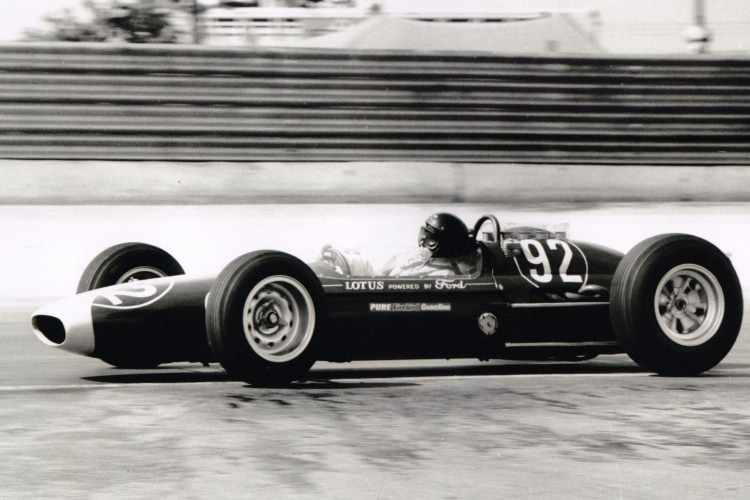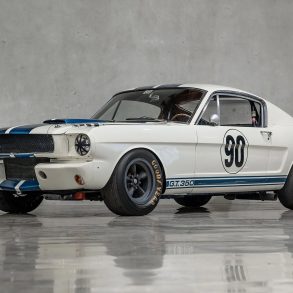Some of you may know the name Ed Iskenderian as one of the high priests of the early days of hot rodding and the birth of the aftermarket speeds parts industry in America. It’s true: Isky’s cams for the flathead Ford and Small-block Chevy V-8s are legendary.
What you may not be familiar with though is Iskenderian’s name and products are most commonly thought of in terms of drag racing or LSR racing at Bonneville.

Today, the 99-year-old Isky doesn’t exactly recall how he got connected with Jim Clark’s Lotus/Ford Indy effort in the early 1960s. It all happened just as USAC Champ Car racing was evolving from front to rear-engined cars. Ford was a long-time Lotus partner and was in on the deal with its own V-8 engine.
It’s essential to recognize that this production-based 256 cubic inch overhead valve was a progenitor to the later, far more exotic double overhead cam Ford Indy V-8 that dominated Indy-style racing from the mid-60s through the 70s.
Architecturally, the original Ford Indy V-8 was highly similar to what you could buy in a production Falcon, Fairlane, Mustang, or Shelby Cobra. Of course, Iskenderian Racing Cams produced hot camshafts for the little Ford motor and somehow was engaged in providing the bumpsticks for rookie Clark’s 1963 Indy 500 effort.

You may recall the ’63 Indy race as an epic duel between Parnelli Jones in his front-engined, Offenhauser powered “Ol Calhoun” Watson roadster and Clark’s more cigar-shaped, lithe and light rear-engined Ford Lotus 29.
After a semi-controversial finish, Jones won the day, with Clark runner up by mere seconds. Isky was, of course, disappointed that the car he provided components for didn’t win but performed admirably, earning a hard-fought second.
Another British connection brought Isky and his valvetrain hardware back to Indy in 1980. Jim Hall’s Chaparral team was running a turbocharged Cosworth V-8 engine in Johnny Rutherford’s car at Indy that year, essentially a turbo version of the famous Cosworth DFV four-cam V-8 that had been dominating F1 since the late 60s.

Isky was contacted by Jim Hall’s famous engine builder Franz Weis, about providing cams for the Indy version of this V-8. Ed recalls that Cosworth provided the unground and unprofiled “camshaft blanks” and some of the calculational math needed to design, profile, and configure them.
Isky, who, of course, understood multiple overhead camshaft technology, was far more used to designing and grinding single “cam in block” camshafts for American V-8s. Figuring out all the math, firing order, and cam profiles necessary for an engine with two intakes and two exhaust cams was a considerable engineering challenge. But his LA area camshaft shop got it done; Rutherford’s “Yellow Submarine” Chaparral was wicked fast, qualifying on pole, and won going away to give LoneStar JR his third and final Indy 500 win.
Needless to say, Isky was damn proud of this accomplishment.
The incomparable Dan Gurney was among Ed Iskenderian’s racing and car-building heroes, as he was to so many of us.

Even though exotic multi-valve, multi-cam, and turbocharged engines of all manufacture and cylinder count were prevalent in Indy Racing during the 60s, 70s, and 80s, Gurney and his All American Racers concern felt there was still great promise and potential in the “stock block” engine formula, sans multiple overhead cams and often sans turbos.
AAR designed and built an aerodynamically advanced Indy racer called the Challenger, ultimately sponsored by Pepsi, around an overhead-valve, cam-in-block, naturally aspirated Donovan-made, Small-block Chevy V-8 architecture.

Running an aluminum alloy block and heads, the 355 cubic inch “stock block” V-8 would crank out around 650 horsepower, more than enough to compete with everything else on the scene at the time.
Having come in contact with Iskenderian from the early 60s Lotus days, Gurney went to “The Camfather” in search of cams and valvetrain for the Challenger. Small-block Chevy V-8? Of course, Isky could design and grind those cams in his sleep.
The Pepsi Challenger was wicked fast everywhere it ran; thus, only about as successful as the Indy racing rules makers would let it be.
Its principal pilots were Mike Mosley and Geoff Brabham; the Challenger never won Indy, but more than proved its mettle at the 1981 CART Milwaukee race where Mosley missed qualifying and had to start last on the grid.
In an epic display of worst-to-first prowess, “Mose” drove the Pepsi machine through the field to take the lead and the win – he was so far ahead that he was beginning to lap some of the backmarkers.

In somewhat typical style, the AAR Challenger was judged more radical than the scope and spirit of the regulations, so it was summarily banned. At least it ran for several seasons in much of its original form, replete with its Isky cammed Chevy V-8, although one year it was badged a Buick. Go figure.
No matter, Gurney was justifiably proud of this car, as was Ed Iskenderian. To hi











in 1969, I put an Iskendrian camshaft in my racing Healey 3000 BN7. Sadly it had such high lift and steep ramps that the first time I took the engine over 5000 RPM, the valves, which overlap the edges of the bore on the Laystall cylinder head, had sufficient float to hit the block and bent all the inlet valves. We had to machine valve reliefs in the top of the block and fit triple valve springs.
isky is a legend
In the nineties I was introduced to Isky by Nissan Motorsport in nearby Gardena California. The used and sold Isky parts. I was running a Datsun 240Z, and started using isky valve springs and retainers. They could be the best in the world.
Then I started using their L4 camshaft in my Z engines. They made more power than any other cam seen by the local Z folk in Sydney Australia. One time I bought a new U20 cam for my Historic Datsun 2000 Fairlady from Nismo Gardena and they took it down to Isky who cut an L 4 grind for me. Amazing results.